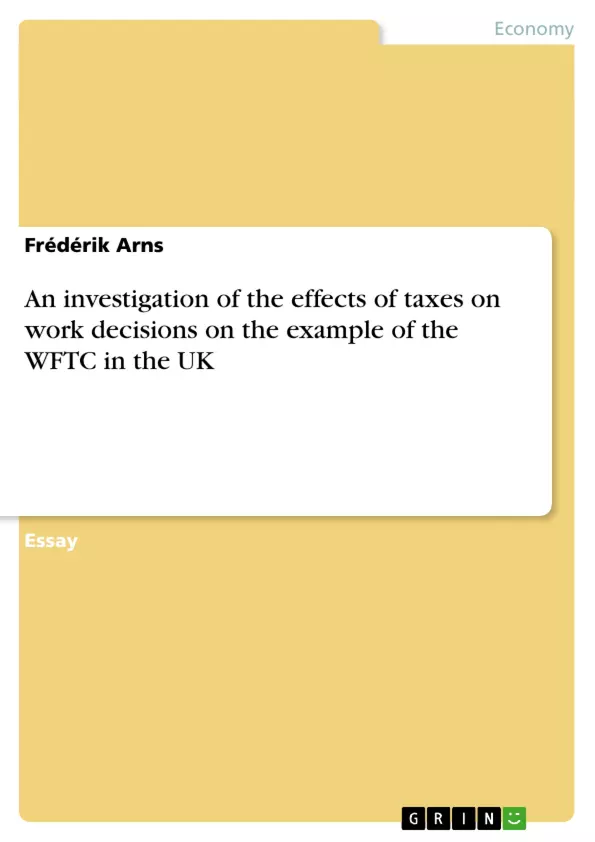This essay deals with the Working Families Tax Credit (WFTC) which was introduced by the UK government in 1999. The WFTC is a wage subsidy for low income workers that is withdrawn above a certain level of income. To evaluate the impact and outcome of the imposition of this tax credit I will first of all use budget line analysis to predict the likely effects of the reform on labour supply.
Inhaltsverzeichnis (Table of Contents)
- Introduction
- The Working Families Tax Credit
- Theoretical Analysis
- Budget Line Analysis
- Effects on Individual Behaviour
- Heterogeneity of Effects
- Empirical Evidence
- Conclusion
Zielsetzung und Themenschwerpunkte (Objectives and Key Themes)
The objective of this essay is to examine the impact of the Working Families Tax Credit (WFTC) on work decisions in the UK. The essay utilizes budget line analysis to predict the effects of the WFTC on labour supply and then analyzes empirical evidence to evaluate the real-world outcomes of the reform.
- Effects of the WFTC on labour supply
- Budget line analysis and its applications in tax policy evaluation
- Income and substitution effects of tax reforms
- Heterogeneity of impacts on different groups of individuals
- Empirical evidence and methodological challenges in evaluating tax policy
Zusammenfassung der Kapitel (Chapter Summaries)
- The essay begins by introducing the Working Families Tax Credit (WFTC), a wage subsidy implemented in the UK in 1999. The WFTC is designed to provide financial support to low-income workers, with the amount of subsidy decreasing as income rises. The essay then outlines the theoretical framework for analyzing the impact of the WFTC, focusing on the use of budget line analysis to predict its effects on labor supply.
- The essay delves into the details of budget line analysis, explaining how it can be used to model the effects of the WFTC on individual behavior. The analysis considers the impact of the WFTC on both hours worked and labor force participation, taking into account the different income and substitution effects it creates.
- The essay identifies six different groups of individuals who are likely to be affected by the WFTC differently. These groups are categorized based on their initial labor force participation status and their reactions to the new incentives provided by the WFTC. The essay then provides detailed descriptions of these groups and their potential responses to the reform.
- The essay concludes by discussing the challenges of conducting empirical research on the impact of the WFTC. It highlights the importance of accounting for the heterogeneity of effects across different groups and addresses the limitations of using difference-in-differences methods for evaluating the WFTC.
Schlüsselwörter (Keywords)
This essay focuses on the Working Families Tax Credit, its effects on work decisions, budget line analysis, labour supply, income and substitution effects, empirical research methods, difference-in-differences approach, and heterogeneity of impacts.
- Quote paper
- Frédérik Arns (Author), 2005, An investigation of the effects of taxes on work decisions on the example of the WFTC in the UK, Munich, GRIN Verlag, https://www.grin.com/document/43098



